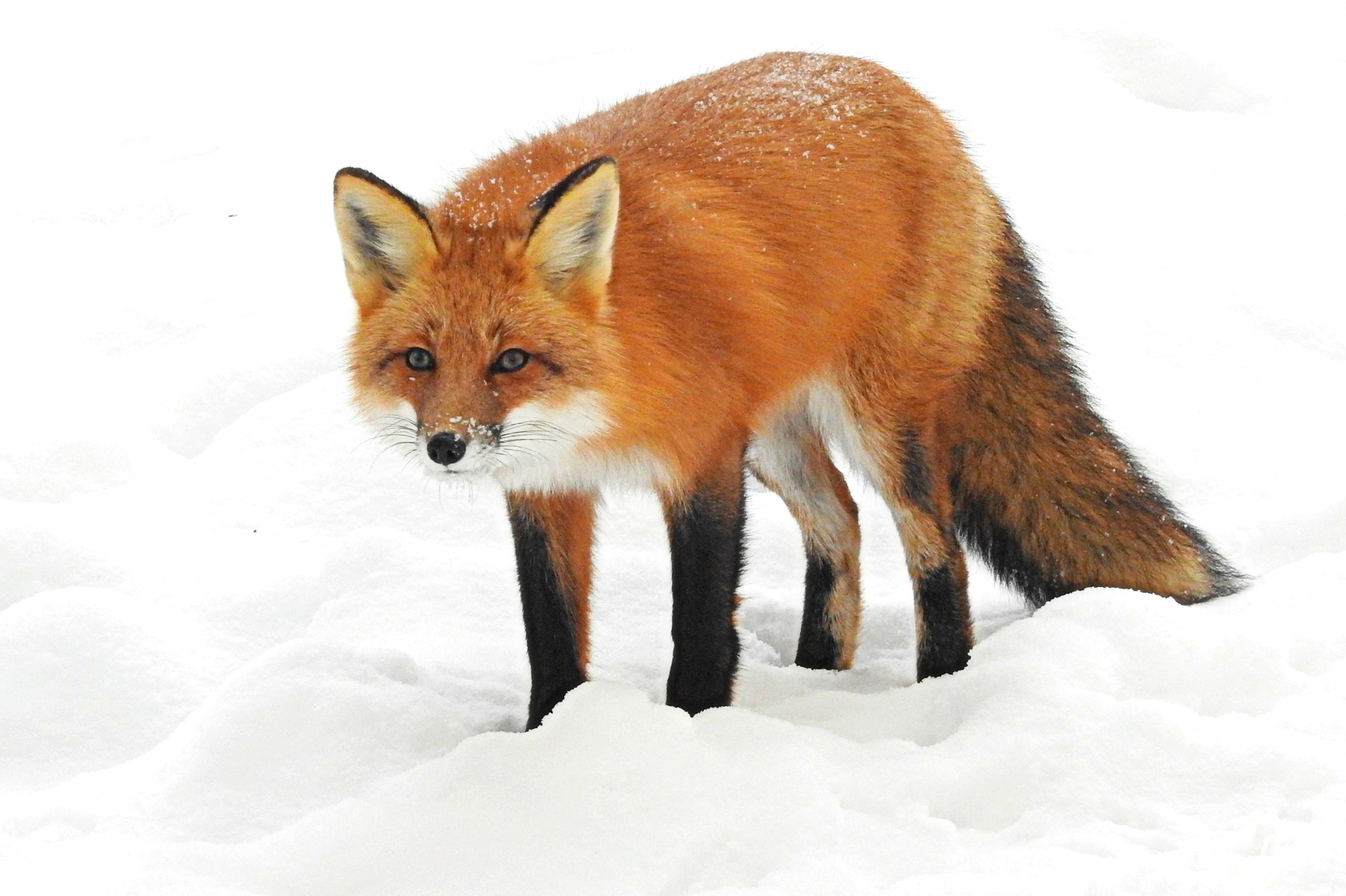One morning when the sun was just coming up, a red fox strolled across the driveway near the road on Owl Acres. In the time that we’ve lived here, that’s the only sighting we’ve had of Mr. Fox. That’s not too surprising really. Foxes are generally nocturnal and will claim and defend an area of from two to five square miles. With lots of territory to patrol, and secretive ways, foxes stay out of the limelight as much as they can. Their most effective predator, sadly, is traffic on the highway.
Red foxes (Vulpes vulpes) are said to be the most widespread land mammal in the world. Subspecies inhabit every continent except Antarctica. They’re native to Europe and Asia and have been introduced to Australia and New Zealand. A subspecies is native to the mountains of Canada and the Western United States. Red foxes were not present on the East coast when Europeans first settled there. Gray foxes were present, but, according to some sources, gray foxes did not play fair in a 17th-century fox hunt. Those rascally gray foxes cheated—they could climb trees and flummox the hounds. Red foxes stayed on the ground and followed the fox hunt rules. Between 1650 and 1750, European red foxes were imported by the wealthy classes to serve the fox hunting traditions. By the mid-1800s foxes, most likely of the European lineage, were common on the Atlantic coast. The foxes spread west along with the pioneers. In 1895 a group of entrepreneurs on Prince Edward Island began raising foxes for their pelts, breeding for the silver coloration. In 1908 a pair of their silver foxes sold for as much as $25,000. The original owners got rich, and wannabes sprung up across the world as fashion dictated silver fox furs.
Meanwhile farmers thought the foxes would eat their chickens (and they would), so an open season on foxes plus bounties and pelt sales continued to encourage 20th-century hunters. Today the fox-hunting season in Iowa is from November 5 to January 31. You have to get a license, but there are no daily or seasonal bag limits.
On average, a red fox is about 25 inches long not counting its bushy tail. It stands about 16 inches at the shoulder and weighs between six and 15 pounds. It has a long nose, amber eyes, and big, black ears. Its back is usually some version of red, and its belly is white. Its legs and ears are black, and its tail is very bushy in mixed reds and black, tipped in white. The fox often curls its tail around to cover its nose and keep warm.
Foxes have exceptional hearing which ranges from very high to very low pitches. They can hear a mouse nibbling under three feet of snow, and can hear it squeak 100 yards away. They also have exceptional olfactory senses and can smell their prey at a distance. A fox will sit still and listen for prey. When it hears that telltale rustle, it hones in on the spot, gathers itself and leaps in a high arc landing squarely on the prospect where it severs the spinal cord and has lunch. A fox’s vision is fairly average, with movement being spotted easily but stationary objects going unnoticed. Because it is nocturnal, it has vertical pupils and, like a cat’s eyes, the fox’s eyes have a reflective layer called the tapetum lucidum that helps with night vision and shines in the headlights.
Although foxes do eat chickens when they can get them, they also eat lots of mice, voles, rabbits and other small pests. They eat from one to two pounds of food a day. That’s a lot of mice at three-quarters of an ounce apiece. Being omnivores, foxes also eat plant material, insects, frogs and anything else that looks tasty.
Fox families stay together throughout the year. They raise only one litter of kits per year. The vixen or female, makes a den where she gives birth about seven weeks after mating. She nurses the kits for a couple of months then starts bringing them food. The kits will venture out by the time they’re ten months old, going off to find a territory of their own.
Foxes have a reputation for being clever. This reputation has persisted throughout time and throughout the world. One of my favorite stories from childhood was “Br’er Rabbit and the Tar Baby.” I loved that fox! I also remember the Aesop fable “The Fox and the Grapes,” although I must confess that I didn’t remember the moral of this little fable. And I thought the fox got drunk—maybe that’s another story. Here it is as a reminder:
One afternoon a fox was walking through the forest and spotted a bunch of grapes hanging from over a lofty branch. “Just the thing to quench my thirst,” said he.
Taking a few steps back, the fox jumped and just missed the hanging grapes. Again, the fox took a few steps back, ran, jumped, and tried to reach them but still failed.
Finally giving up, the fox turned up his nose and said, “They’re probably sour anyway,” and proceeded to walk away.
It is easy to despise what you cannot have.
Do you have a favorite fox-centered story or fable? Let us know in the comments.
Photo from Wikimedia.org by Joanne Redwood. Alt text: A red fox stands in a stark white snowscape looking at the camera. Large, erect, black-edged ears, pointy snout, bushy tail and amber eyes with vertical pupils.

1 comment
I truly enjoy your posts. Thanks. When you put the together in a book, I want one!!